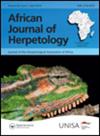在南非夸祖鲁-纳塔尔省德班的Bluff自然保护区和宝藏海滩,对德班侏儒穴居石龙子Scelotes inornatus (Smith 1849)进行了有针对性的调查,并记录了同属爬虫动物
IF 0.9
4区 生物学
Q2 Agricultural and Biological Sciences
引用次数: 0
摘要
研究人员于2021年8月和9月在南非德班的两个保护区对极度濒危的德班矮钻穴石龙子Scelotes inornatus (Smith 1849)进行了调查。利用挖掘样方、陷阱-漏斗-陷阱阵列和覆盖板阵列,对12个地点进行了采样,每个地点都包括植被类型、海拔、坡度和坡向的组合。每种取样方法至少记录1只,共记录7只。在森林边缘和林草交错带的草地部分捕获个体,在森林内部没有捕获个体。所有的采样方法都不适合长期监测无痕葡萄球菌,尽管使用陶土瓦片代替瓦楞瓦片对覆盖板阵列进行了改进,但应该进行测试。将捕获的5只野鼠引入约翰内斯堡动物园的迁地保险和圈养繁殖种群。调查期间还记录到其他9种同域爬行动物,其中捕获最多的是1849年的Bush Squeaker Arthroleptis wahlbergii Smith,第5位是S. inornatus。本研究提供了一些有用的信息,以解决一些保护行动和研究需要的石龙子,但需要对石龙子的生物学(特别是其生活史和种群规模)和栖息地管理干预(栖息地的恢复和恢复)进行更多的研究,以帮助改善其保护状况。本文章由计算机程序翻译,如有差异,请以英文原文为准。
A targeted survey for the Durban Dwarf Burrowing Skink Scelotes inornatus (Smith 1849) at Bluff Nature Reserve and Treasure Beach in Durban, KwaZulu-Natal, South Africa, with notes on sympatric herpetofauna
A survey for the Critically Endangered Durban Dwarf Burrowing Skink Scelotes inornatus (Smith 1849) was conducted in two protected areas in Durban, South Africa, in August and September 2021. Twelve sites, each encompassing a combination of vegetation type, elevation, slope and aspect, were sampled for S. inornatus using dug quadrats, pitfall-and funnel-trap arrays, and coverboard arrays. Seven S. inornatus were recorded, at least one by each sampling method. Individuals were captured at the forest edge and in the grassland part of the forest-grassland ecotone and none were captured in the interior of the forest. None of the sampling methods were suitable for the long-term monitoring of S. inornatus, although a modification of the coverboard array using terracotta tiles instead of corru-board tiles should be tested. Five S. inornatus captured were introduced to the Johannesburg Zoo’s ex-situ insurance and captive-breeding population. Nine other sympatric species of herpetofauna were recorded during the survey, with the Bush Squeaker Arthroleptis wahlbergii Smith, 1849 the most caught and S. inornatus ranking fifth. This study provides information that is useful for addressing some of the conservation actions and research needed for S. inornatus, but more research on the biology of this skink (particularly on its life history and population size) and habitat management interventions (restoration and rehabilitation of its habitat) are required to assist with improving its conservation status.
求助全文
通过发布文献求助,成功后即可免费获取论文全文。
去求助
来源期刊
CiteScore
2.60
自引率
6.70%
发文量
0
审稿时长
>12 weeks
期刊介绍:
African Journal of Herpetology (AJH) serves as an outlet for original research on the biology of African amphibians and reptiles. AJH is an interdisciplinary journal that publishes original articles and reviews from diverse fields and disciplines, such as conservation, phylogenetics, evolution, systematics, performance, physiology, ecology, behavioural ecology, ethology, and morphology.
The Journal publishes two issues a year. There are no page charges .

 求助内容:
求助内容: 应助结果提醒方式:
应助结果提醒方式:


